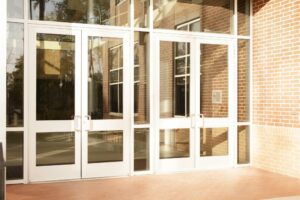Here’s the thing nobody tells you at the hardware store: exterior and interior doors have almost nothing in common except their shape.
One is designed to separate your bedroom from your hallway. The other is engineered to be the barrier between your home and everything nature throws at it, wind, rain and temperature swings. Choosing wrong doesn’t just cost you money. It costs you comfort, security, and sometimes repairs that make the original door price look like pocket change.
Here’s what you need to know before you get door installation in NYC.
Exterior Vs. Interior Door Installation
1. Weatherproofing
Why Interior Doors Don’t Need It
Interior doors live in climate-controlled environments. Room temperature stays relatively stable. Humidity might fluctuate a bit, but there’s no rain, snow or direct sunlight.
Standard interior door installation in NYC doesn’t include weather stripping, drip caps, or sill pans because these doors will never face weather. You hang the door in the frame, adjust it so it closes properly, and you’re done.
Why Exterior Weatherproofing Is Important
An exterior door without proper weatherproofing is a disaster waiting to happen. We’re talking water damage, mold growth, rot in the door frame, and energy bills that make you question whether you accidentally left a window open all winter.
Professional exterior door installation in NYC includes multiple weatherproofing layers:
- Sill pans sit under the door threshold and catch any water that somehow makes it past the exterior seals.
- Flashing wraps around the door frame like weatherproofing tape, preventing water from seeping behind the frame and into the wall cavity.
- Weather stripping creates a seal around the entire door perimeter, compression strips on the sides and top, and sweep seals at the bottom threshold.
- Drip caps are installed above the door to direct water away from the top of the frame. Without them, water runs down your exterior wall and finds its way into the door assembly.
- Caulking seals the final gaps between the door frame and the exterior wall material.
2. Hardware
Interior Hardware Offers Privacy and Convenience
Interior door hardware prioritizes ease of use. Privacy locks on bathrooms and bedrooms use simple button or twist mechanisms that can be easily overridden from the outside with a small tool. The latch mechanisms are lightweight, the strike plates are thin stamped metal, and the screws holding everything together are short.
Interior hinges use brass or basic steel, often just held with 3/4-inch screws into the door jamb. They’re not designed to support heavy weight or resist forced entry.
Exterior Hardware Includes Security-Grade Components
Exterior door hardware meets entirely different standards. Exterior locks need to resist picking, drilling, and physical attacks while operating reliably in temperature extremes and humidity.
Deadbolts are standard on exterior doors, providing the 1-inch bolt throw that actually secures the door. The deadbolt mounts with long screws that reach through the door jamb and into the wall framing, creating a connection that’s exponentially stronger than a simple surface-mounted interior latch.
Strike plates on exterior doors are heavy-gauge metal plates secured with 3-inch screws that reach the wall studs.
3. Installation Complexity
Interior Installation is Straightforward When Done Right
Installing a pre-hung interior door in an existing frame takes a competent DIYer maybe two hours. You remove the old door, check that the new frame fits the rough opening, shim it level and plumb, secure it with finish nails or screws, and trim it out.
The tolerances are forgiving. If the door is slightly out of square, it’s unlikely to cause major problems. If you forget to insulate around the frame, the worst consequence is slightly reduced sound insulation between rooms.
Mistakes are fixable without major cost.
Exterior Installation is Where Experience Matters
Exterior door installation is a different story altogether. A professional installation takes 4-8 hours, depending on complexity, and that doesn’t include time for custom trim work or fixing underlying structural issues.
The sequence matters. Install components out of order, and you create problems that won’t show up until the first major rainstorm. Miss a step in the weatherproofing process and you’ve built a water infiltration point into your home’s envelope.
The tolerances are tight.
Also Read: How to Tell When It’s Time to Replace Your Interior Doors
4. Material Choices
Interior Door Materials
Hollow-core doors use a wooden frame with honeycomb cardboard inside. They’re incredibly lightweight and affordable, making them perfect for closets and basic bedroom doors. Their main disadvantage is sound transmission, they do almost nothing to block noise.
Solid-core doors fill the interior with particleboard, MDF, or composite materials. They’re heavier, more expensive, and provide substantially better sound insulation. They’re popular for bedrooms and home offices where noise control matters.
Exterior Door Materials
Steel doors are a popular option, and for good reason too. They’re affordable, secure, energy-efficient, and low-maintenance.
Fiberglass doors offer the best weather resistance and lowest maintenance. They never need painting, won’t warp or rot, and maintain their integrity through temperature extremes. They’re particularly good for NYC’s humid summers and harsh winters.
Getting It Done Right
Understanding the differences between interior and exterior doors prevents expensive mistakes and helps you make informed decisions about your home improvement projects.
Door Guys NYC is your go-to door installation company. We handle both interior and exterior door installation in NYC, but we’ll be the first to tell you that these are fundamentally different projects.
Whether you need a simple bedroom door replacement or a complete entry door system, we bring the experience and attention to detail that separates installations that last from those that create problems.
Contact us for a quote on your next door project, we’ll make sure you get the right door installed the right way.






